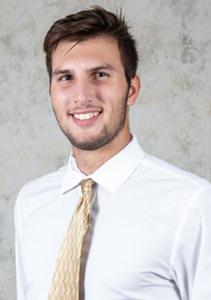
Freshman pitcher Nick Pave suffered an injury to his anterior rotator interval during his senior year of high school. Pave had surgery in July 2018 and is still recovering from the injury. (Courtesy of Lehigh Sports)
The Yankees, the Red Sox, the Dodgers. All Major League Baseball teams with billions of dollars to spend on injury prevention and care for their players. Yet, they all still experience pitching-related injuries.
Whether it’s the Patriot League or the Major League, pitchers get hurt, but the reasoning behind these injuries cannot be consolidated to one.
There are two things that every pitcher wants to accomplish: to throw harder and stay healthy. These two things are easier said than done due to the sheer fact that each pitcher is different. When one gets hurt, many go looking for the one game or the one throw that was the end-all. When in reality, that one throw doesn’t exist.
These injuries occur from a buildup of different variables over the years, varying from learning the wrong form to throwing in the wrong climate. Some may think it’s inevitable for a pitcher to sustain an injury in their career. But with the right routine, it’s not impossible.
“It’s important to know that there is no linear or singular process,” said Dan Gusovsky, the Lehigh baseball team’s pitching coach. “Pitching coaches across the country have different thoughts and approaches. For different guys, that means different things.”
For Gusovsky, his approach is all about individualizing the development of the pitcher in terms of movement on and off the ball based on their strengths.
“The pitcher’s body is much like a car in that it will go as fast as its ability to stop,” Gusovsky said. “The lat muscle and labrum are like the decelerating muscles. The better we can strengthen and keep them congruent, the better we can keep those three groups maintained, bettering our ability to develop.”
In order to maintain those three areas, Gusovsky enforces a regimented “prehab” and recovery program that he says is essential in reducing lactic acid buildup. The usage of J-Bands, foam rollers, lacrosse balls, cardio and technology that measures spin metrics to pitches are all involved in his program to ensure that the pitcher is becoming the best he can be.
“As a whole, baseball is getting away from one conventional, cookie-cutter approach to a more diverse individual approach,” Gusovsky said.
Similarly enough, Owen Breininger, ’06, an assistant strength and conditioning coach, recognizes that players come from all sorts of backgrounds and need a routine to follow as well.
“The sport has gotten really good at proactively doing things to prevent injury,” Breininger said. “A lot of kids come to us already with a decent background in injury prevention as far as arm care. A lot of them have their own routine.”
Breininger has been running the baseball strength and conditioning program for the last six years and is a previous Mountain Hawk himself.
He prides himself on the fact that within the last five years, there hasn’t been a non-existing shoulder injury to occur here at Lehigh from his pitchers.
This could be in part due to the year-round strength and conditioning program he brought with him for his players to follow. Players come to Breininger with all levels of experience and rather than throwing a new routine onto the guys, he works with what they have and adjusts as needed.
“We still get a wide range,” Breininger said. “We see people who have never squatted before, have squatted but have terrible form, or have squatted and have great form. Most of our guys come in with at least some foundational knowledge. A lot of time, the guys who are hurt and come with pre-existing injuries, they didn’t. It’s not their fault.”
Freshman pitcher Nick Pave knew something wasn’t right when his arm always hurt after throwing the beginning of his senior year.
He tore his anterior rotator interval, which is the socket that your bicep goes through when it comes into your shoulder. He had surgery to correct the injury in July 2018 and he’s still in the process of recovering.
Although Pave doesn’t know exactly when or why his injury happened, he said he thinks having the knowledge about baseball-specific training that he has here would’ve helped prevent it.
“My high school didn’t really provide us with a strength and conditioning program and it was more on you as a player to figure it out,” Pave said. “I brought my own exercises to practice and we weren’t provided with injury prevention.”
Basic arm care like band exercises, shoulder specifics, light weights and running were all things Pave learned here at Lehigh to help tailor his pitching style. It’s essential for pitchers to keep their routine consistent due to the fact that pitching itself is detrimental to the arm.
“Pitching as a whole is not a natural human activity,” Gusovsky said. “It’s all about maintaining your strength and preparing the body for the abuse that it’s ultimately going to have.”
Now that people are realizing that and starting to gather the resources to help better the issue, it’s up to the parents and coaches to instill them into their children’s routines from a young age.
“The ‘prehab’ stuff, if you start at a young age, obviously cannot hurt,” Breininger said. “Most of the research coming out in regards to youth is about managing their workloads. If they have poor mechanics coupled with a poorly managed workload, that will most likely lead to injury.”
Parents understanding that it’s important for their children to take time off from the game and rest is important because their bodies are simply not done developing.
It’s a similar situation with concussions, according to Breininger. Nowadays, parents and coaches are more cautious about their kids’ “minor collisions” because they know the damage that can result from it in the years to come.
“It took 20 years to get to the point where we’re at now with concussions,” Breininger said. “I think it’s the same thing with arm injuries with pitchers. We are definitely making progress in the field and it’s heading in that direction.”





Comment policy
Comments posted to The Brown and White website are reviewed by a moderator before being approved. Incendiary speech or harassing language, including comments targeted at individuals, may be deemed unacceptable and not published. Spam and other soliciting will also be declined.
The Brown and White also reserves the right to not publish entirely anonymous comments.